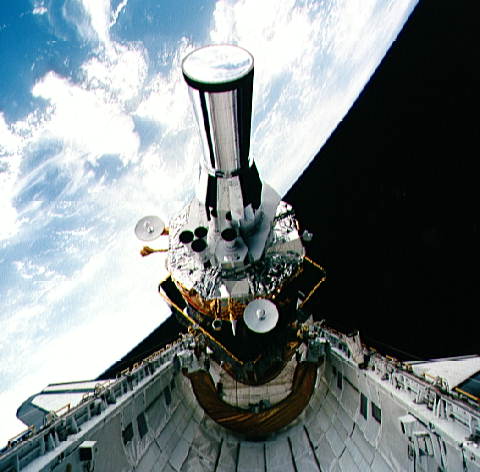 |
| Military satellites that constitute a missile early-warning system also pick up inbound meteors. |
The change is a blow to the astronomers and planetary scientists who used the information to track space rocks, especially those that burn up over the oceans or in other remote locations. "These systems are extremely useful," says Peter Brown, an astronomer at the University of Western Ontario in London, Canada. "I think the scientific community benefited enormously."
When the policy changed is unclear. The website Space.com reported the end of the relationship on 10 June, but Brown says that he was told at the beginning of this year that there would be no further data releases. Mark Boslough, a physicist at Sandia National Laboratories in Albuquerque, New Mexico, says he was told this spring that he could no longer publicly discuss the classified data to which he had some access. Neither scientist could give a reason for the end of the arrangement, and the United States Air Force, which operates the satellites, did not respond in time for Nature's deadline. The Air Force did issue a 16 March memo on the military classification of fireball data, but Nature could not confirm its contents.
The Defense Support Program satellite network is part of the Pentagon's early-warning system. Since 1970, 23 infrared satellites in the series have been launched into geosynchronous orbit to monitor the globe for missile launches or atmospheric nuclear blasts.
But the same infrared sensors were perfect for spotting fireballs as they streaked across the atmosphere, according to Brian Weeden, a former Air Force captain who now works at the Secure World Foundation, a non-profit organization based in Superior, Colorado. The satellites could precisely detect the time, position, altitude and brightness of meteors as they entered Earth's atmosphere. Weeden, who left the Air Force in 2007, says that the military didn't consider that information particularly useful, or classified. "It was being dropped on the floor," he says.
 |
| Defense Support Program satellite. |
Under an informal arrangement, at least some of the data seem to have been provided on an ad-hoc basis to scientists studying meteorites. Often it came in the form of an anonymous, tersely worded e-mail describing the coordinates, altitude and size of a fireball. Brown, who has collected the data since 1994, declined to specify who sent the reports.
Even the short descriptions of events were enormously helpful. In 2002, Brown and his colleagues used a larger data set from the satellites to quantify the number of objects striking Earth each year (P. Brown et al. Nature 420, 294–296; 2002). Last year, they were used to narrow the search for remnants of the asteroid 2008 TC3 in the Sahara Desert in North Africa, and they were also crucial in recovering a meteorite fragment in 2000 from Tagish Lake in northern Canada. "In both of those cases it's hard to say whether this would have been picked up without the satellite data," Boslough says.
The data also provide a useful check against ground-based instruments monitoring low-frequency sound waves and dust from the fireball explosions, says Brown.
Although the reason for ending the arrangement remains unclear, Weeden notes that it coincides with the launch of a new generation of surveillance satellites. The US$10-billion-plus Space-Based Infrared System will provide a more detailed infrared picture of Earth for battlefield surveillance, early-warning alerts and the US missile defence programme.
The first of these satellites was launched in 2006 in a highly elliptical orbit and entered operational service in November 2008, a month after Brown received his last report. In its final configuration, the system will include at least two satellites in highly elliptical orbit and three or more geosynchronous satellites for a whole-Earth view.
Weeden speculates that the Pentagon may not want details of the new satellites' capabilities to be made public, or it may simply lack the expensive software needed to handle classified and declassified data simultaneously. "The decision may have been made that it was perhaps too difficult to disclose just these data," he says.
Brown says that whatever the reason, the end of the relationship has left the tight-knit meteorite community smarting. The global reach of the satellites and the data they supplied were unparalleled, he says. "There's nothing else that even comes close," he says.
Nature